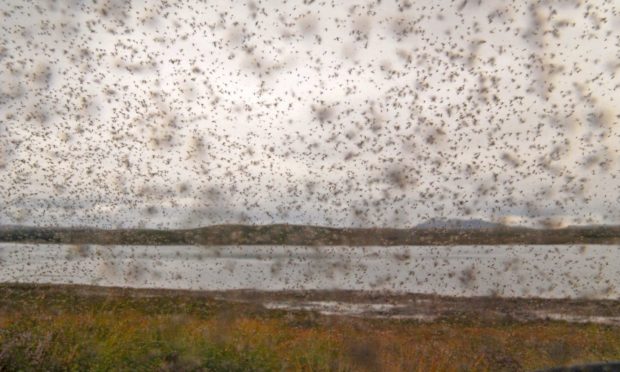Midge populations could be unusually high following recent hot and humid weather, according to experts.
The Scottish Midge Forecast says that due to varying weather patterns, midges hatched within a smaller timeframe, unlike in previous years.
Due to cold spring, hatchings were delayed until the weather turned warm, resulting in a large first hatching.
Dr Alison Blackwell told the BBC that if it remained damp or humid she would expect a “mega second generation” to start hatching.
Midges thrive in warm, humid conditions and Dr Blackwell believes there has been sufficient moisture in the air to allow populations to explode.
This can be seen through the interactive map on the Scottish Midge Forecast website which shows which areas are most affected.
According to the map, the west coast of Scotland could see very high numbers of midges, including areas such as Glencoe a popular tourist location.
Glencoe has been rated five, with forecasters recommending insect repellent, with Fort William, Spean Bridge, and Torridon rated four for the next five days.
However, much of the east coast has low levels of midges but this may be because of the abundance of damp, peaty soil found nearer the west coast.
It allows the midge larvae to lie in wait during the winter before the warmth helps them grow into adults.
According to Dr Blackwell, due to the relatively dry conditions, midge populations were very low last year.
She said: “Now we’ve got a big starting population, it means that the levels will stay quite high now throughout the summer probably unless there’s a really dry heatwave.
“At the minute it’s quite humid which is perfect for them.”
Normally midges would first hatch towards the end of May but this has been delayed due to colder conditions.
While they can be annoying, Dr Blackwell notes midges are important for ecosystems breaking down plant matter and making up the diet of small birds.
What attracts midges?
Midges are first attracted to people by their breath.
The CO2 provides a signal to midges that a food source is nearby, so they look for other signs, including body odour, heat, humidity and movement.
If a pregnant midge finds you she will signal to all her friends to come join the buffet she’s found.
Advice to avoid midge bites includes covering exposed skin while outdoors, using insect repellant, light citronella candles or using essential oils such as peppermint or eucalyptus.
To keep updated with midge populations in your area, visit the Scottish Midge Forecast.


Conversation